Add this eBook to your basket to receive access to all 78 records. Our indexes include entries for the spelling orgill. In the period you have requested, we have the following 78 records (displaying 61 to 70): These sample scans are from the original record. You will get scans of the full pages or articles where the surname you searched for has been found. Your web browser may prevent the sample windows from opening; in this case please change your browser settings to allow pop-up windows from this site. Officers of H. M. S. Dido, in the Home Fleet
(1904)
The Monthly Naval List for November 1904, printed By Authority for the Admiralty, contains this List of Ships and Vessels of the Royal Navy with their Officers and Present Stations. The number after the name of the ship denotes the number of guns of 4-inch calibre and upwards. The tons represents the displacement tonnage. A letter P. in bold denotes Paddle Wheel; S. Single Screw. The italic abbreviations are F. D. Forced Draught; I. H. P. Indicated Horse Power; N. D. Natural Draught. All officers whose names are in italics are borne as supernumeraries or additions. (G) against an officer's name denotes that he is borne for gunnery duties; (N) navigating; (T) torpedo. In the cases where two dates are shown against the names of marine officers, the date in brackets is that from which his present sea time commenced. | Sample scan, click to enlarge
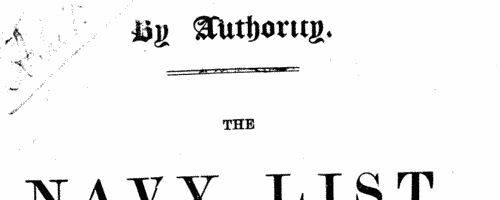
| Officers of the Royal Navy
(1904)
The Monthly Naval List for November 1904, printed By Authority for the Admiralty, contains this Alphabetical List of the Officers on the Active List of the Royal Navy and the Royal Marines with the Dates of their Seniority. The first column 'Where serving' gives the number of the ship; the second column gives full name, surname first, but with middle names represented only by initials; the third column rank; and the fourth column seniority, i. e., the date of attaining that rank. Lieutenants whose seniorities are printed in italics are on the Supplementary List, and Engineer Lieutenants whose seniorities are printed are those not yet advanced. | Sample scan, click to enlarge
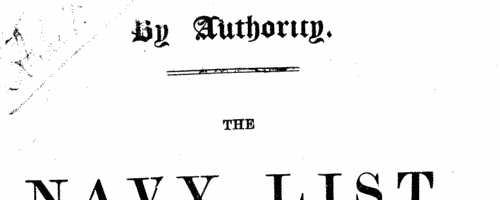
| Lodgers in Buxton in Derbyshire
(1916)
The 1916 Directory of Buxton includes this semi-alphabetical 'List of Lodger Voters in Buxton, Fairfield, Burbage and Hartington-Upper-Quarter. (Entitled to vote as Parliamentary Voters, but not as County Electors.)' | Sample scan, click to enlarge

| Residents of Buxton in Derbyshire
(1916)
The 1916 Directory of Buxton includes this alphabetical list of residents with their addresses. It includes Fairfield, but not Harpur Hill. | Sample scan, click to enlarge
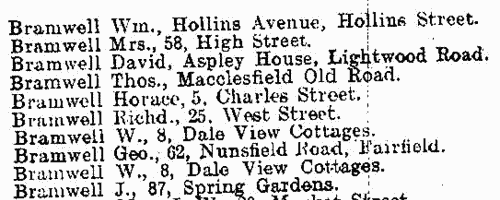
| Soldiers killed: Yorkshire Regiment
(1916)
Lists of names of soldiers wounded, died of wounds, died, missing presumed dead, and taken prisoner by the enemy, were issued to the British national press under the title Roll of Honour. Each man is identified by surname, initials and number. The regimental returns from which the daily Roll was compiled were made up over the previous week or weeks. Each regimental return may be partial, covering only part of the alphabet. The lists are provisional, in that a man reported wounded one day may appear as died of wounds later; a missing presumed dead may later be reported as having been found, or as having died; the lists of prisoners of war were provided by the enemy and will relate to captures weeks earlier. However, these rolls are the most comprehensive single source of names of British and allied combatants meeting with misfortune in the Great War. This is the roll published 2 August 1916. | Sample scan, click to enlarge
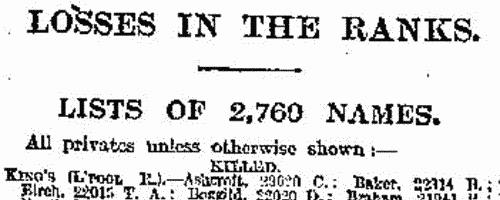
| Soldiers wounded in the Great War: Australian Infantry
(1916)
Lists of names of soldiers wounded, died of wounds, died, missing presumed dead, and taken prisoner by the enemy, were issued to the British national press under the title Roll of Honour. Each man is identified by surname, initials and number. The regimental returns from which the daily Roll was compiled were made up over the previous week or weeks. Each regimental return may be partial, covering only part of the alphabet. The lists are provisional, in that a man reported wounded one day may appear as died of wounds later; a missing presumed dead may later be reported as having been found, or as having died; the lists of prisoners of war were provided by the enemy and will relate to captures weeks earlier. However, these rolls are the most comprehensive single source of names of British and allied combatants meeting with misfortune in the Great War. This is the roll published 4 August 1916. | Sample scan, click to enlarge

| Naval Officers
(1920)
The alphabetical list of officers on the Active List of the Royal Navy and Royal Marines (RM) and of the Retired and Emergency Officers serving gives: number of ship or where otherwise serving; name (surname, first christian name and initials); rank; and the dates of their seniority. This is the list from the March 1920 edition of the Navy List, corrected to 18 February 1920.
| Sample scan, click to enlarge
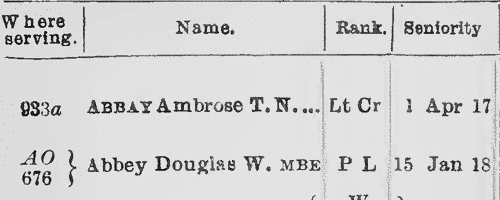
| Boys entering Haileybury College, Hertfordshire
(1925)
Haileybury College, near Hertford, was founded by the East India Company in 1806, and incorporated by Royal Charter in 1864. This register of pupils entering the school from 1862 to 1931 was edited by a master there, Laurence Arthur Speakman. The boys are listed by term of joining the school, and then alphabetically by name (in bold), surname first (in capitals). There is then usually a precise birthdate, and the name and address of his father; his period at the school, starting with abbreviations to indicate the house to which he belonged (B., Batten; B. F., Bartle Frere; C., Colvin; E., Edmonstone; Ha., Hailey; Hi., Highfield; L., Lawrence; Le B., Le Bas; M., Melvill; Th., Thomason; T., Trevelyan), and the first and last forms attended (e. g., IV., fourth form). Where a member of a school team there is then an indication (e. g., XI., cricket).
| Sample scan, click to enlarge
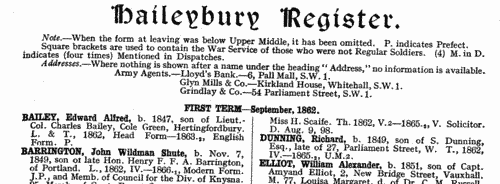
| Boys entering Haileybury College, Hertfordshire
(1928)
Haileybury College, near Hertford, was founded by the East India Company in 1806, and incorporated by Royal Charter in 1864. This register of pupils entering the school from 1862 to 1931 was edited by a master there, Laurence Arthur Speakman. The boys are listed by term of joining the school, and then alphabetically by name (in bold), surname first (in capitals). There is then usually a precise birthdate, and the name and address of his father; his period at the school, starting with abbreviations to indicate the house to which he belonged (B., Batten; B. F., Bartle Frere; C., Colvin; E., Edmonstone; Ha., Hailey; Hi., Highfield; L., Lawrence; Le B., Le Bas; M., Melvill; Th., Thomason; T., Trevelyan), and the first and last forms attended (e. g., IV., fourth form). Where a member of a school team there is then an indication (e. g., XI., cricket).
| Sample scan, click to enlarge
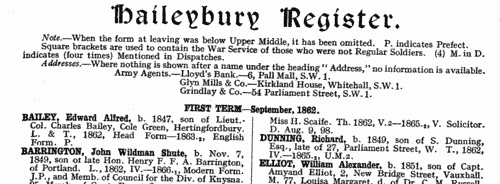
| Anglican clergy
(1930)
Crockford's Clerical Directory listed all Anglican clergy in the British Isles, India, the colonies, Europe, Asia and South America. The 59th annual issue, for 1930, is based on returns from all the individuals listed. The details given are: name (surname first, in capitals) in bold, prefixed by an asterisk in the case of university electors, and by a dagger whether the return had not been made, or it had been imperfectly filled up; name of theological college and/or university, and degrees, with years; a bold d followed by year and diocese signifies date of ordination as deacon and by which bishop; then a bold p, similarly for ordination as priest; posts (C: curate; I: incumbent; V; vicar; R: rector) with parishes and years; address; telephone number; and lists of books &c. where appropriate. In the case of the man then holding an English, Irish, Scottish or Welsh benefice, additional details are given - a bold P signifies the patron of the advowson; then the income, with items such as Q. A. B. (Queen Anne's Bounty), Eccles(iastical) Comm(issioners), Fees, e. o. (Easter Offerings), Pew Rents, T(ithe) R(ent) C(harge), Gl(ebe), &c. | Sample scan, click to enlarge
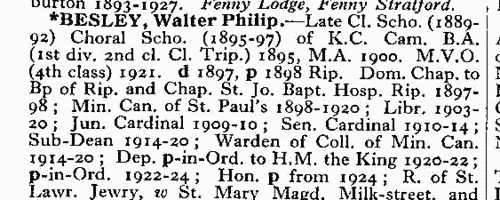
|
Research your ancestry, family history, genealogy and one-name study by direct access to original records and archives indexed by surname.
|











